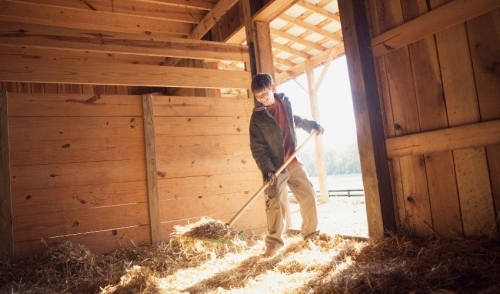
Organizing and Cleaning the Barn
With different animals moving back and forth, seasonal changes for equipment use and storage, and the ever-changing needs of livestock and new agricultural practices, your barn can quickly get cluttered, disorganized, and dirty. It is easy, however, to organize and clean your barn for better safety and more efficiency.
Why Clean Up?
Your barn will inevitably get dirty, so why bother cleaning it only to need to redo those chores? A dirty, disorganized barn can cause many dangerous and costly problems, such as…
- Lost equipment that may be replaced, only to be found again
- Equipment and tools that break because of improper storage
- Rodents and pests that spoil food supplies or cause other damage
- Trip obstacles that can injure animals and humans
- Fire hazards that can turn a spark into an inferno
Fortunately, simple organization and cleaning tasks can quickly eliminate these potential problems and hazards, saving you time, money, and aggravation.
12 Easy Tips to Clean and Declutter Your Barn
There are many ways to clean and organize your barn, and you need to find the methods that work the best for your barn, its functions, and the needs of your animals. Using as many techniques as possible can help you keep a clean, decluttered barn where it will be easy to find tools and equipment, where your animals will be safe, and where you can efficiently accomplish any necessary task.
- Discard or repair unusable equipment and chemicals immediately.
When a tool breaks, it should be repaired right away or else discarded safely so it is not mistaken for functional equipment. Similarly, leftover chemicals that will not be used before they are ineffective should be disposed of safely.
- Discard, sell, or donate excess or unneeded equipment.
It’s easy to accumulate duplicate and triplicate tools and gear, but instead of stockpiling items you don’t need, sell them or consider donating them to local facilities such as horse therapy programs or other outreach facilities.
- Designate proper storage areas for all gear.
Whether you use cubbies, lockers, bins, hooks, or shelves, provide a proper place for all your tools and gear. Use labels or color-coding to designate what items belong where, and always replace items after use so they can easily be found when needed.
- Use proper, secure tool storage.
Be sure all your tool storage is firmly secure so tools will not fall or slip if accidentally bumped. Falling onto a concrete barn floor can break a tool or dull a blade and make the equipment unusable, but secure storage will keep every tool firmly in its place.
- Clear off the floor.
A cluttered floor makes slips, trips, and stumbles more likely, which could cause injury to you or your animals as well as damage equipment. Keep gear off the floor as much as possible, storing it in a tack room or in proper storage so it is not at risk.
- Organize creatively.
Think outside the box for creative storage options to make the most of every inch of space in your barn. Consider over-the-door shoe racks, bathroom organizers, and other creative solutions for storing smaller items more conveniently.
- Store grain and food securely.
Use rodent-proof metal or heavy plastic bins with secure lids to store grain and other foods so they will not be contaminated by unwelcome guests. Secure food storage will also minimize lost food to better protect the food and your feed budget as well.
- Rotate food supplies often.
As you stockpile food and grain, rotate your oldest supplies forward so they will be used first. This will minimize spoilage and ensure you are offering your animals the food with the best nutrition.
- Keep lighting adequate.
If you don’t see dirt and clutter, you can’t clean it up. Use the appropriate size lightbulbs in all fixtures, and change burned out lightbulbs right away. Keep windows clean to let in natural light for even better visibility.
- Sweep or use a blower or shop-vac regularly.
Getting dirt, bits of hay, dust, and other debris off the floor will keep your entire barn cleaner. Sweep daily if possible, or use a blower or shop-vac to remove dirt and debris so the floor is clean and neat.
- Dust and remove cobwebs regularly.
Dust and cobwebs will quickly accumulate on railings, rafters, doorways, and other surfaces, and can increase the risk of fire or help a fire spread more quickly if one does spark. Weekly dusting can minimize this risk and keep your barn clean.
- Keep nails and screws secure.
Investigate all gates, railings, walls, and joints each month for any protruding or loose nails, screws, or other fasteners. Even a small nail can cause injuries that can lead to dangerous infections, and loose boards can fall or splinter more easily.
In addition to these small tasks, simply staying alert to the condition of your barn can help you keep it organized and clean. Check windows, gutters, and roofs each season for wear or damage, and ensure that gates and doors move freely and close securely. Locks should function easily, and all electrical outlets, water spigots, and faucets should perform as expected.
Develop Tidy Habits
It can seem like a lot of work to keep a barn organized and clean, but if you do a little at a time and attend to small tasks as soon as they need doing, the work won’t pile up. When you use a tool, return it to its proper place and make sure it is secure. If something falls on the floor, pick it up right away so it is not a trip hazard. If you see a nail popping out of a board, hammer it back in quickly so it won’t cause scrapes or loosen any further.
At the same time, make sure everyone using your barn is aware of your organization and cleanliness preferences. Establish routines so everyone can pitch in to keep the barn in top shape, and teach everyone how to take care of basic maintenance and messes. When small tasks are taken care of as needed, your barn will be organized and clean at all times.
